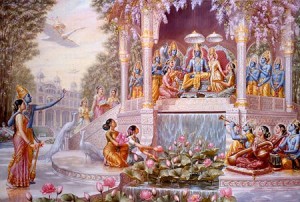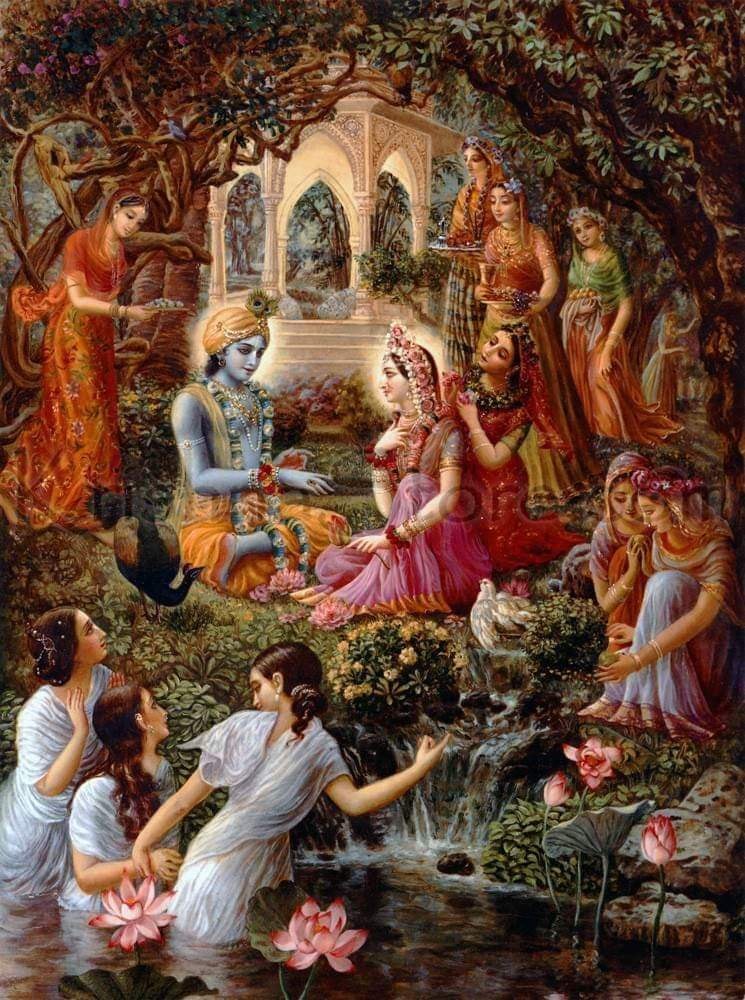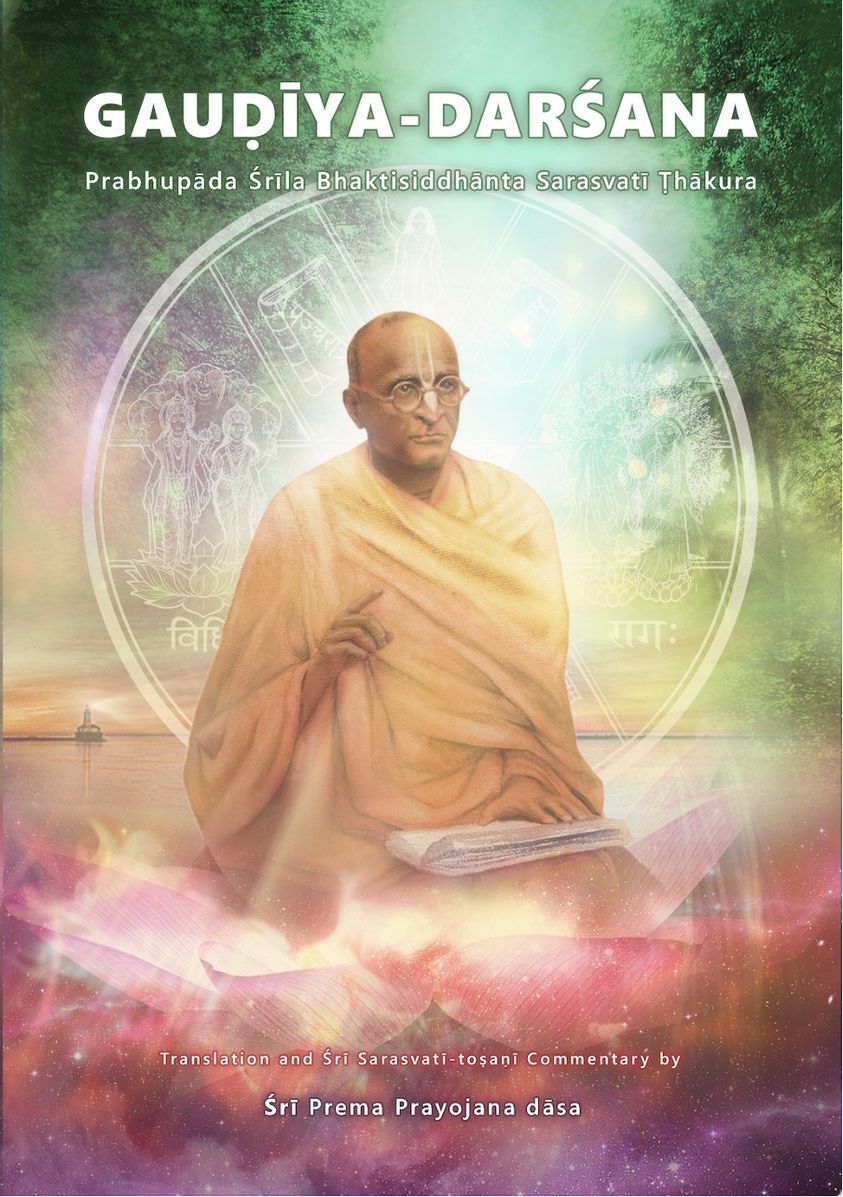Not Even A Peacock Feather Falls From Vaikuntha Page Two
Page Two
On this page we continue with various answers from many different devotees, to the question “When the spirit soul returns to the Spiritual World does he have the same relationship with Krishna as before he came here to the Material World?” Each new paragraph represents a new answer, given by different devotees. There are many more quotes and statements from scripture, but here we have posted a few replies.
Vaikuntha
Question: When the spirit soul returns to the Spiritual World does he have the same relationship with Krishna as before he came here to the Material World?
-
They come to carry out the order of the Supreme Lord its not as if they fall.
-
They descend dont they. Like the Lord and his associates descend. A fall is like when I have this human form of life, I could "fall" into a lower form of life in my next life. A fall indicates an accident, descent indicates some intent.
-
In the ISKCON GBC Position booklet (OOPs p. 194) it is stated that the residents of the spiritual world have the free will to leave, as a crazy man has the free will to jump off the roof. In this booklet they state that these residents are indeed crazy (bewildered) when they leave. This explanation is very insubstantial and misleading. In the material world we always have the choice between matter and spirit but in the spiritual world there is no matter so one will not and cannot choose matter.
-
The living entity enmeshed in maya sees no viable choice besides maya, in the sense that he is attached and thinks that this life of maya is in his best interest. Although he has the free choice to choose spiritual life, he sees this as a threat to his sense gratification and therefore undesirable. In the spiritual world however, the living entity, fully absorbed and overwhelmed with ecstatic love, cannot bear the thought of doing anything averse to Lord Krishna's interest—seeing this as a threat to his continued absorption in pure loving ecstatic devotional service—his very life. In the spiritual world, all the living entities are fully self-realized. As shown below in section 6a, they have fully realized the conclusions of sastra—that they are an eternal servant of the Lord, and they are fully experiencing their realizations of eternal blissfulness. It is not that they know every last detail of sastra. For example, some of the gopis were previously the Personified Vedas. Although as gopis, they are celebrated as exhibiting the highest standard of devotion and are recognized as such by Sri Chaitanya Mahaprabhu—ramya kacit upasana vraja-vadhu-vargena, they had almost no knowledge of the Vedas, and state as much in their wonderful prayers upon meeting their beloved Krsna after so long at Kuruksetra. (Bhag. 10.82.48) Yet we should not agree with them that they are ordinary girls simply engaged in household affairs. They are the personification of the Vedas, absorbed in the highest mellows of devotion—krishna-prema.
-
They don't come ever to enjoy the material world. If that was the case we would all be ex-associates of Krishna living here, such a mass exodus from Goloka or Vaikuntha is not described in sastra. There are no such accidents in Vaikuntha, but it is described that when The Lord comes to perform pastimes that some of His associates come with him to facilitate His pastimes. Like personalities as Rupa Goswami for example, they always remember their positions and who they are, whereas we don't even know what's going on half the time. That is the difference.
-
The Conclusion is that when you get your spiritual body then the desire will be different. And that is prema…in the spiritual world, because there is no material body, only desire is how to satisfy Krsna. Kama krishna karmarpane. (761127SB.VRN)
-
In the Vaikuntha planets there is actual, spiritual ananda. Krishna is there in His ecstatic, spiritual form, surrounded by His blissful associates, all of them eternally full of bliss and knowledge. They have nothing to do with material existence. In the spiritual planets even the scenery and birds and animals are fully conscious of Krishna and are absorbed in transcendental bliss. (Bhag. 11.2.37, purp.)
-
The jivas originate from the tatastha…. Innumerable references from prominent acaryas, some of which are given below, clearly and repeatedly state that the marginal jivas originate from the tatastha-sakti of Lord Krishna and not in the spiritual (cit-sakti) realm itself.
-
It should be understood that the jiva soul is neither produced of this material world, nor created in the transcendental world. They are originated from the marginal line between the transcendental and mundane spheres. (Tattva Viveka 2.4, by Srila Bhaktivinoda Thakura, page 55)
-
There are two types of jivas liberated from maya: nitya-mukta, eternally liberated, and baddha-mukta, those who were bound but became liberated. The jivas who were never bound by maya are called nitya-mukta. The nitya-muktas are also of two types, aisvarya gata nitya mukta and madhurya gata nitya mukta. The former are the associates of Lord Narayana in Vaikuntha and are the atomic particles from mula Sankarsana. The latter are the associates of Lord Krishna in Goloka. They are the atomic particles of Sri Baladeva situated in Goloka Vrndavana. (Jaiva-Dharma, Chapter 17, p. 251)
-
Bhaktivinode Thakura says in Prema-Pradipa – "The individual soul naturally resides in Vaikuntha. If he somehow comes to the material world, the individual soul brings with him his spiritual form made of chit. Pervertedly reflected in the material world these things of chit are called by name matter.
-
[Srila Narayana Gosvami Maharaja:] The jiva is cit-sakti. The theory of tatastha-sakti has been told only as an example. In fact, there is no tatastha as a specific area between the spiritual and material worlds. Tatastha as a line between two worlds is imaginary. Tatastha sakti is also cit-sakti because the tatastha-sakti is also cit (conscious); not inert. *[See Endnote 4]
-
According to Visnu Purana, Bhagavad-gita and all other Vedic literature's, the living entities are generated from the tatastha energy of Lord Krishna (Bhag. 3.7.9, purport) .
-
Origin of Jiva According to Bhaktivinoda Thakur The jiva appeared by the marginal energy at the dividing line between spirit and matter. From that position, he began to gaze at the spiritual and material worlds. Those jivas who were attracted somewhat to realization of the Supreme Person ( Krishna) became desirous of the spiritual realm because of that contact of knowledge. They then obtained strength from the hladini potency of the abundant cit sakti, which made them favorable to the Lord eternally, and they were brought into the spiritual world as associates of the Lord. Those who, by their own free will, became bewildered and became greedy for maya situated on the opposite side, being beckoned by maya, then became attracted to the material universe, and were thrown in the universe by Karanarnavasayi Visnu, the controller of maya. That was but the result of their eternal aversion to the Supreme Lord. The moment they entered the material realm, they became overcome by ignorance, the function of maya. Overcome by ignorance, they fell into the wheel of binding karma in order to become fully absorbed in their task." (Mahaprabhura-siksa ch.7)
- Among the unlimited potencies of Sri Krishna, there is one known as tatastha-sakti (border-potency). From that sakti comes out the jiva-souls remaining at the junction of the two worlds, viz., the transcendental and the mundane ones, may contact them both. In its composition it is only the atomic cit (pure sentience) . . . On account of the purity in its composition, it has got the capacity for being the eternal denizen with divine bliss in the transcendental power." (Jaiva Dharma, chapter 4).
-
The semblance or dim reflection of the internal Cit-potency is the jiva-sakti (potency) or tatastha-sakti stationed in between cit-jagat and a-cit-jagat or mayika-jagat whereas the shadow or perverted reflection of that internal cit potency is the maya-sakti or external a-cit potency. All the jivas emanate from the tatastha-sakti of God and accordingly the mundane worlds emanate from the maya-sakti of God." (Bhagavat-arka Marici-mala, chap. 1, Intro)
- The jiva-souls are emanated from the jiva-sakti of Sri Krishna and they are spiritual but atomic. In the very self of the jiva-soul or in his constitution practically there remains no maya. As jiva-souls are atomic in size and being emanated from the tatastha-sakti of Sri Krishna (viz. from the intermediary-potency which exists in between cit-jagat and mayika-jagat) jiva-soul is liable to be subjected to maya when he becomes averse to his constitutional right of serving the Lord. Jiva-soul in bondage misconstrues himself as the doer and enjoyer, therefore is affinated to the adopted bodies that are provided by prakrti. A jiva by dint of spiritual virtue may possess steadfast devotion to Sri Krishna and getting rid of worldly affinity goes back to the abode of bliss." (Bhagavat-arka Marici-mala, ch. 7, text 34, purport)
-
Krishna is endowed with unlimited potencies. His complete potency (purna-sakti) is perceived in the manifestation of the spiri-tual world, cit-jagat. Similarly, His tatastha-sakti, or marginal potency, is observed in the manifestation of the jivas. A special potency acts in assembling the finite world (apurna-jagat), and this potency is known as tatastha-sakti. The action of the marginal potency is to create an entity (vastu) which exists between the animate objects (cid-vastu) and inanimate objects (acid-vastu) and which can maintain a relationship with both the spiritual and material worlds. Purely transcendental entities are by nature quite the opposite of inanimate objects, and therefore have no connection whatsoever with them. Although the jiva is an animate spiritual particle, he is capable of a relationship with inanimate matter due to the influence of aisi-sakti, a divine potency, which is known as the tatastha-sakti.
-
The boundary region between land and the water of a river is known as a tata or shore. This tata may be considered to be both land and water; in other words, it is situated in both. The divine aisi-sakti, which is situated in the border region, upholds the properties of both land and water, as it were, in one existential entity. The jiva’s nature is spiritual, but still, his composition is such that he can become controlled by jada-dharma, the inert nature. Therefore the baddha-jiva (conditioned soul) is not beyond all connection with matter, unlike the jivas in the spiritual domain. Nonetheless, he is distinct from dull matter because of his animate, spiritual nature. Since the jiva is by nature different from both the purely spiritual entities and dull matter, he is classified as a separate principle. Therefore, the eternal distinction between Bhagavan and the jiva must be accepted.
-
The inhabitants of Vrindavana are all pure devotees. Their destination after quitting the body is Krishnaloka. They even surpass the Vaikunthalokas. The fact is that those who are always engaged in Krishna consciousness and mature, pure devotional service are given the chance, after death, to gain Krishna’s association in one of the universes within the material world. Krishna’s pastimes are continuously going on, either in this universe or in another universe. Just as the sun globe is passing over many places across this earthly planet, so krishna-lila, or the transcendental advent and pastimes of Krishna, are also going on continuously, either in this or another universe. The mature devotees, who have completely executed Krishna consciousness, are immediately transferred to the universe where Krishna is appearing. In that universe the devotees get their first opportunity to associate with Krishna personally and directly. The training goes on, as we see in the vrindavana-lila of Krishna within this planet. Krishna therefore revealed the actual features of the Vaikuntha planets so that the inhabitants of Vrindavana could know their destination. Krsna Book Chapter 28 Srila A.C Bhaktivedanta Swami Prabhupada.
-
How does the soul first appear in this world? From what stage of spiritual existence does he fall into the material world?" This is a broad question, which requires some background information.There are two classes of souls, jivas, who come into this world. One class comes from the spiritual Vaikuntha planets by the necessity of nitya-lila, the eternal pastimes of Krsna. Another comes by constitutional necessity.The brahmajyoti, the nondifferentiated marginal plane, is the source of infinite jiva souls, atomic spiritual particles of nondifferentiated character. The rays of the Lord's transcendental body are known as the brahmajyoti, and a pencil of a ray of the brahmajyoti is the jiva. The jiva soul is an atom in that effulgence, and the brahmajyoti is a product of an infinite number of jiva atoms.Generally, souls emanate from the brahmajyoti which is living and growing. Within the brahmajyoti, their equilibrium is somehow disturbed and movement begins. From nondifferentiation, differentiation begins. From a plain sheet of uniform consciousness, individual conscious units grow. And because the jiva is conscious it is endowed with free will. So, from the marginal position they choose either the side of exploitation or the side of dedication.Krsna bhuli sei jiva anadi bahirmukha. Anadi means that which has no beginning. When we enter the land of exploitation, we come within the factor of time, space, and thought. And when we come to exploit, action and reaction begins in the negative land of loan. Although we strive to become masters, really we become losers.Goloka and Vaikuntha servitors are also seen to be within the jurisdiction of the brahmanda, the material universe, but that is only a play, lila. They come from that higher plane only to take part in the Lord's pastimes and then return. The fallen souls come from the marginal position within the brahmajyoti, and not from Vaikuntha. " Search for Sri Krsna Reality the Beautiful. Chapter Four. Srila Bhakri Raksaka Sridhara Maharaja.
-
Bhaktivinode Thakura says in Prema-Pradipa – The individual soul naturally resides in Vaikuntha. If he somehow comes to the material world, the individual soul brings with him his spiritual form made of chit. Pervertedly reflected in the material world these things of chit are called by name matter.
-
Babaji: There are unlimited jivas who are eternal associates of the Lord. In Goloka Vrndavana they are manifested by Lord Baladeva for the service of Lord Krsna. In Vaikuntha they are manifested by Sri Sankarsana for the service of Lord Narayana, the Lord of Vaikuntha. They are eternally and blissfully engaged in the service of their svarupa, always striving to make the Lord happy, always favorable to the service of the Lord, and always powerful with the energy of the cit-sakti. They have absolutely no relation or contact with the inert maya. Indeed, they do not even know that there is an energy called maya. Because they live in the spiritual region, maya remains very far from them. They are always absorbed in the bliss of service to their worshipable Lord. They are transcendental to mundane misery and happiness and are always liberated. Their very life is love, and they have no conception of lamentation, fear, and death.
-
The atomic conscious jivas, who come out like rays from Maha-Visnu's glance at maya, are also uncountable. Being in proximity to maya, these jivas see the variegatedness of maya. They have all the characteristics of the ordinary jivas as described before, yet because of their atomic nature they sometimes glance marginally towards the spiritual creation and sometimes towards the material creation. In this marginal state the jiva is weak, because he has not yet attained spiritual power by the mercy of the worshipable Lord. Out of these unlimited jivas, the ones who desire to enjoy maya remain eternally bound by maya, because of being attached to sense enjoyment. Those who engage in devotional service to the Lord go to the spiritual world getting the strength of the cit-sakti by the mercy of the Lord…
-
Vrajanatha: Lord Krsna is the embodiment of mercy. Why did He make the jiva weak and thereby cause his bondage by maya? (Note: Jiva here refers only to the conditioned souls).
Babaji: It is right that Krsna is merciful, but He is also lilamaya, or one who performs only lila. Considering that various types of lilas will be performed under various situations, the Lord made the jiva competent for unlimited gradations of positions from the marginal state up to the topmost platform of mahabhava. To facilitate the jivas and make them firm in their competence for these various positions, He created many low levels associated with maya which present unlimited obstacles in the attainment of the Supreme bliss. These range from the lowest inert matter up to false ego. The living entities bound by maya are in ignorance of their svarupa, engaged in acquiring pleasure for themselves, and not devoted to Krsna. In this state, as much as the jiva goes down that much more the merciful Lord, becoming manifest before him along with the facility to attain the ultimate destination. Those jivas who accept that facility try to achieve this highest destination. Gradually they reach the transcendental abode of the Lord and attain the exact same status as His eternal associates.
http://www.bvml.org/SBNM/ytle.html…See More









